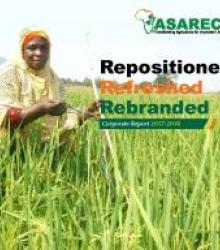| Title | Author | Full Text | Asbract |
|---|---|---|---|
| Eastern Africa Plant Genetic Resources Network | ASARECA | ASARECA_EAPGREN.pdf | As part of measures to address the challenge of climate change on worldÔÇÖs food production and agriculture, scientists recommend to search for genes in wild and traditional varieties of common food crops that could help plants to adapt to variable weather conditions, resist pest and disease, tolerate drought and produce sustainable yield. For this to happen, crop diversity must be properly conserved and easily accessed.. |
| Staple Crops Programme | ASARECA_Staples.pdf | Staple crops are a crucial source of food, feed, raw materials, improved nutrition and employment and are a major source of income. The Staple Crops Programme focuses on banana, cassava, maize, millet, potato, rice, sorghum, sweetpotato and wheat, which are priority staples in the region. |
|
| ASARECA working to deliver the CAADP agenda | ASARECA | ASARECAnCAADP(1).pdf | ASARECA sees improved delivery and impact of scientific knowledge, policy options and technologies as a powerful instrument to drive the sub-region towards meeting the Comprehensive African Agricultural Development Program (CAADP) which is the agricultural agenda of the African Union's, New Economic Partnership for African Development (AU/NEPAD). |
| Functions of ASARECA | ASARECA | Functions of ASARECA(1).pdf | Develop a shared vision and sub-regional goals |
| Describes ASARECA Vision and Mission | ASARECA | ASARECA,Vision Mission Banner(1).pdf | The Association for Strengthening Agricultural Research in Eastern and Central Africa (ASARECA) is a sub-regional not-for-profit association. It was established in 1994 by ten member countries represented by their national agricultural research for development institutes. The 10 member countries are: Burundi, Democratic Republic of Congo, Eritrea, Ethiopia, Kenya, Madagascar, Rwanda, Sudan, Tanzania, and Uganda. |
| Establishment, management and use of Calliandra calothyrusus (Calliandra) | ASARECA | calliandra_edited(1).pdf | Calliandra is a multipurpose tree species grown primarily for forage as a supplement to low quality roughages for ruminant livestock. It a source of green manure; provides shade for coffee and tea, stakes for climbing beans, is a source of wood fuel for cooking; controls soil erosion, and is a source of pollen for honey production.Calliandra leaf hay is a potential source of income as the demand for hay is now very high. Leaf hay is used to make nutrient feed blocks in addition to other locally available materials such as molasses, maize bran, cotton seed cake, farm waste and crop residues |
| Functions of ASARECA | ASARECA | Develop a shared vision and sub-regional goalsEmpower end-users of the programmes of the Association to ensure their meaningful participation in developing priorities for agricultural research, training, extension and education |
|
| ASARECA working to deliver the CAADP agenda | ASARECA | ASARECAnCAADP.pdf | ASARECA sees improved delivery and impact of scientific knowledge, policy options and technologies as a powerful instrument to drive the sub-region towards meeting the Comprehensive African Agricultural Development Program (CAADP) which is the agricultural agenda of the African UnionÔÇÖs, New Economic Partnership for African Development (AU/NEPAD). |
| ASARECA working to deliver the CAADP agenda | ASARECA | ASARECA sees improved delivery and impact of scientific knowledge, policy options and technologies as a powerful instrument to drive the sub-region towards meeting the Comprehensive African Agricultural Development Program (CAADP) which is the agricultural agenda of the African UnionÔÇÖs, New Economic Partnership for African Development (AU/NEPAD). |
|
| Describes ASARECA Vision and Mission | ASARECA | ASARECA,Vision Mission Banner.pdf | The Association for Strengthening Agricultural Research in Eastern and Central Africa (ASARECA) is a sub-regional not-for-profit association. It was established in 1994 by ten member countries represented by their national agricultural research for development institutes. The 10 member countries are: Burundi, Democratic Republic of Congo, Eritrea, Ethiopia, Kenya, Madagascar, Rwanda, Sudan, Tanzania, and Uganda |
| Establishment, management and use of Calliandra calothyrusus (Calliandra) | ASARECA | Calliandra is a multipurpose tree species grown primarily for forage as a supplement to low quality roughages for ruminant livestock. It a source of green manure; provides shade for coffee and tea, stakes for climbing beans, is a source of wood fuel for cooking; controls soil erosion, and is a source of pollen for honey production.Calliandra leaf hay is a potential source of income as the demand for hay is now very high. Leaf hay is used to make nutrient feed blocks in addition to other locally available materials such as molasses, maize bran, cotton seed cake, farm waste and crop residues |
Search
Brochures/Leaflets
Copyright © 2025. All rights reserved.
Designed By ASARECA


